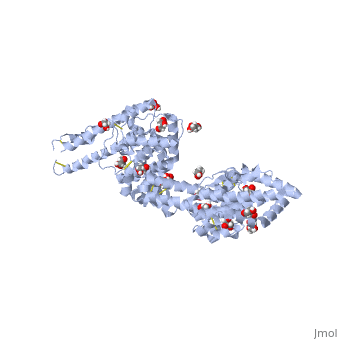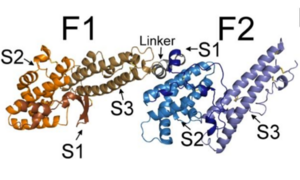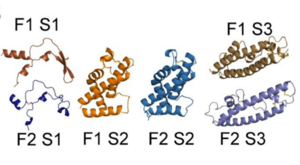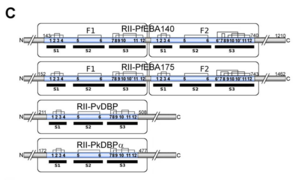Malaria Parasite Plasmodium falciparum Erythrocyte Binding Antigen 140
From Proteopedia
IntroductionIn 2010, malaria caused over 650,000 deaths.[1] While this disease is both preventable and curable, many of those that live in areas where the disease is endemic do not have access to such resources. Although there is a vaccine currently undergoing clinical trials, results are not expected until 2014.[1] The most recent vaccine research has focused on understanding a group of proteins in the erythrocyte-binding ligand (EBL) family. These proteins, which are found in the Plasmodium species, facilitate entry into erythrocytes during malarial infection by creating tight junctions between the host erythrocytes and parasite membranes. [2] There are four family members: erythrocyte-binding antigen 175 (PfEBA-175), erythrocyte-binding ligand 1 (PfEBL-1), erythrocyte-binding antigen 140 (PfEBA-140), and erythrocyte-binding antigen 181 (PfEBA-181).[2] PfEBA-140 binds glycophorin C on host erythrocytes,[2] which helps maintain erythrocyte shape and regulates membrane material properties.[3] Understanding the mechanism by which PfEBA-140 recognizes and engages glycophorin C on erythrocytes may lead to the future development of a new malaria vaccine, as it has been found to be immunogenic.[4] General StructureThe EBL family members, including PfEBA-140, are made up of two regions, region II (RII) (shown to the right) and region VI.[2] Region II is responsible for receptor binding in all EBL family members.[2] RII is composed of , F1 (purple) and F2 (teal).[2] These two DBL domains are connected by a .[2] The DBL protein fold is unique to the Plasmodium species. Not only does it have the ability to recognize and bind many erythrocyte cell receptors, but it also mediates microvasculature adherence of infected erythrocytes by erythrocyte membrane protein 1 (PfEMP1).[2] Each DBL domain is composed of three subdomains, illustrated in the pictures to the right. In the top image, the subdomains S1, S2, and S3 of each of the F1 and F2 domains, as well as the helical linker, are illustrated.[2] In the bottom image, structures of the individual subdomains are illustrated.[2] The colors are the same in both images: F1 subdomain 1 is shown in bronze, subdomain 2 in orange, subdomain 3 in dark orange; F2 subdomain 1 is shown in dark blue, subdomain 2 in blue, and subdomain 3 in light blue.
Binding of RII PfEBA-140Requirement of Both DBL DomainsSince the DBL domains of RII are highly conserved, the ability of the individual DBL domains to bind erythrocytes was tested. To do this, constructs containing the full-length RII PfEBA-140 and each individual DBL domain were tested using a rosetting assay. Both brightfield microscopy and green fluorescence protein (GFP) were used to visualize erythrocyte binding. In the upper panel, a construct expressing only GFP was used as a control. The lower panel of Figure A illustrates the extensive erythrocyte binding of the full length RII construct. In Figure B, the lack of black dots in the brightfield microscopy and the smaller quantity of green fluorescence illustrates that F1 and F2 are unable to independently bind erythrocytes. This result suggests that both domains equally participate in engaging erythrocytes.[2] Basic PatchSince the two DBL domains bind acidic GPC, there must be a number of basic charges that interact with the acidic GPC residues. This idea is supported by visualizing the found in RII PfEBA-140. The positive side chain residues are bue while the negative side chain residues are red. On the side shown, there are a number of residues with positive side chains, creating a basic patch. This basic patch, which forms an arch spanning the two DBL domains, is thought to interact with the acidic GPC, because if the molecule is flipped 180°, there is no concentration of positive charges. The basic patch may be better visualized in the picture to the right.[2] To test whether this basic patch was indeed responsible for erythrocyte binding, two residues in each DBL domain were chosen and mutated to Alanine. In F1, these residues were and . In F2, these residues were and . When these four residues were individually mutated to Alanine, erythrocyte binding was heavily interrupted. This can be observed in the figure to the right.[2] The decreased erythrocyte binding confirms that these found in the basic patch of RII PfEBA-140 are crucial to erythrocyte binding. As a control, residues on the opposite side of RII PfEBA-140 were mutated to Alanine. These residues were Asn394 and Glu605. Mutation of these two residues had no effect on erythrocyte binding.[2] These results fortify the finding that erythrocyte binding takes place in the basic patch discussed earlier.Structural Differences in PfEBA-140 from other EBL LigandsThere are three unique structural elements that set RII PfEBA-140 apart from other EBL ligands. These structures are the likely reason behind RII PfEBA-140 binding GPC so specifically. Disulfide BondsThere are twenty-six in RII PfEBA-140, all of which are involved in (disulfide bonds shown in black).[2] In RII PfEBA-140, two modified disulfide patterns were found to be different than in RII PfEBA-175, RII PvDBP, and RII PkDBP. In the latter three RII domains, there is a disulfide linkage between Cys7 and Cys9 and between Cys8 and Cys12. In RII PfEBA-140, however, Cys7 is disulfide bonded to Cys8, and Cys9 is disulfide bonded to Cys12.[2] Alpha Helix StructureAnother difference between RII PfEBA-140 and other EBL ligands can be found in the F2 domain. In EBL ligands of other Plasmodium species, there are β-fingers with either long or short loops which may or may not be important for receptor binding.[2] While this β-finger is found in F1 of PfEBA-140, it is not found in F2, as it is replaced with an .[2] Lack of Kink in F1A third difference between RII PfEBA-140 and other EBL ligands is the lack of a glycine residue in F1. This glycine is present in F1 and F2 of PfEBA-175, PvDBP, PkDBP-α, and F2 PfEBA-140. In F2 PfEBA-140, this glycine is residue 627.[2] In these EBL ligands there is a kink due to glycine's flexibility. If this glycine residue were present in F1 of PfEBA-140, it would result in a kink in subdomain 3.[2] This kink would create a hinge angle between the two DBL domains that would allow for dimerization of PfEBA-140 upon erythrocyte binding. For this reason, PfEBA-140 is believed to engage erythrocytes as a monomer, unlike other EBL ligands, which bind erythrocytes as a dimer. These three structural differences are believed to be responsible for the specificity of RII PfEBA-140. | ||||||||||||
References
- ↑ 1.0 1.1 http://www.who.int/mediacentre/factsheets/fs094/en/index.html
- ↑ 2.00 2.01 2.02 2.03 2.04 2.05 2.06 2.07 2.08 2.09 2.10 2.11 2.12 2.13 2.14 2.15 2.16 2.17 2.18 2.19 Lin DH, Malpede BM, Batchelor JD, Tolia NH. Crystal and Solution Structures of Plasmodium falciparum Erythrocyte-binding Antigen 140 Reveal Determinants of Receptor Specificity during Erythrocyte Invasion. J Biol Chem. 2012 Oct 26;287(44):36830-6. doi: 10.1074/jbc.M112.409276. Epub 2012, Sep 18. PMID:22989878 doi:10.1074/jbc.M112.409276
- ↑ http://en.wikipedia.org/wiki/Glycophorin_C
- ↑ Ford L, Lobo CA, Rodriguez M, Zalis MG, Machado RL, Rossit AR, Cavasini CE, Couto AA, Enyong PA, Lustigman S. Differential antibody responses to Plasmodium falciparum invasion ligand proteins in individuals living in malaria-endemic areas in Brazil and Cameroon. Am J Trop Med Hyg. 2007 Nov;77(5):977-83. PMID:17984363






